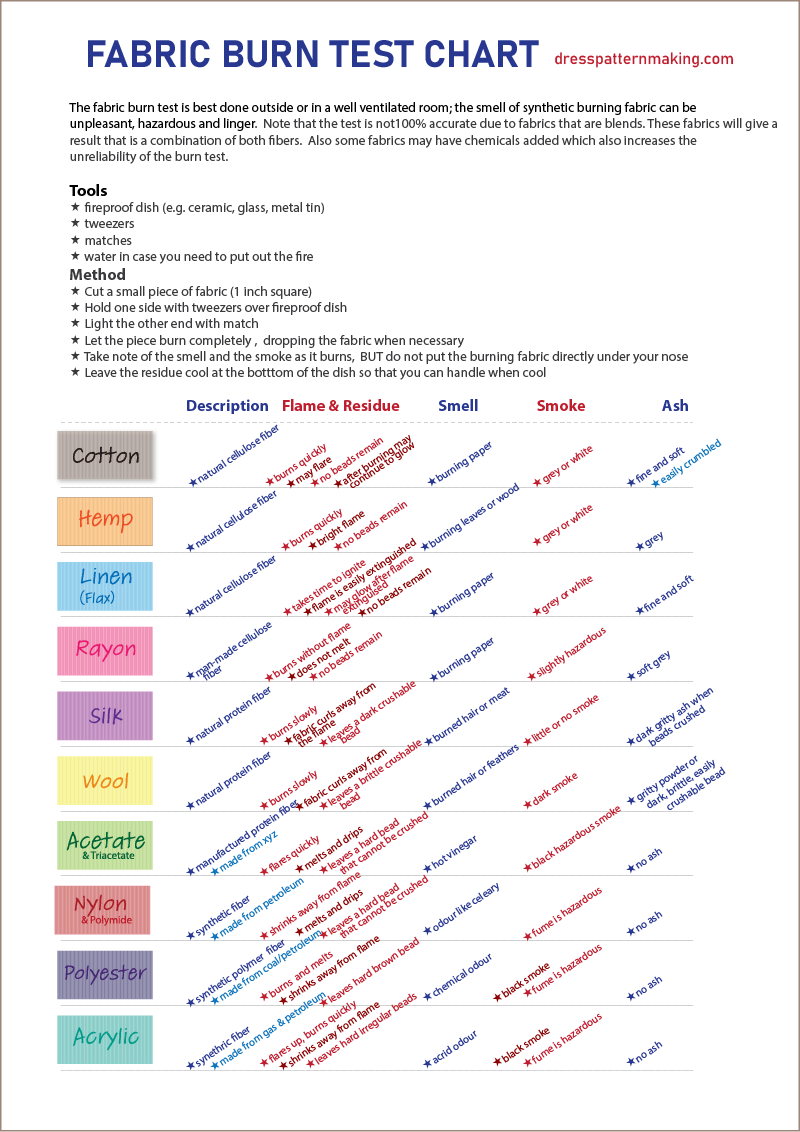Fabric Burn Test Chart

If you don't know what kind of fabric you have.... I sometimes buy fabric at a thrift store, and sometimes I'm not sure what kind of fabric it is. I don't usually use synthetic fabric for making clothing, but if it's cheap enough I'll buy it to stablise other fabric*; it is especially useful when cutting slipping fabrics like viscose, and even more so when cutting bias strips (Note: The fabric has to be really cheap to make it worthwhile, as it end up being a 'throw-away' fabric). However before using it as ''throw-away' stabilizing fabric, I check by doing a burn test. I am sometimes pleasantly surprised and find that I have ended up with some good quality fabric. The burn test isn't 100% reliable as there are fabrics that a mix of synthetic and natural, but it's a good starting point.
Although there is a lot of information on the web for doing burn tests, I couldn't find a chart with all the information laid out in a table. So I created one and have it available here for download. To get all the information on the chart, it does end up having quite small font, but you may find it useful. Download the Fabric Burn Test Chart here in PDF format.. The same information that is contained in the downloadable chart is repeated here below (for search engines, as they can't read the PDF file).
Determining fabric type by doing a Burn Test
The fabric burn test is best done outside or in a well ventilated room; the smell of synthetic burning fabric can be unpleasant, hazardous and linger. Note that the test is not 100% accurate due to fabrics that are blends. These fabrics will give a result that is a combination of both fibers. Also some fabrics may have chemicals added which also increases the unreliability of the burn test. (I use the burn test mainly to check whether it is 100% natural or not. You will be able to tell if the fabric is 100% natural fiber like wool, cotton, etc).
Tools
- fireproof dish (e.g. ceramic, glass, metal tin)
- tweezers
- matches
- water in case you need to put out the fire
Method
- Cut a small piece of fabric (1 inch square) Hold one side with tweezers over fireproof dish
- Light the other end with match
- Let the piece burn completely , dropping the fabric when necessary
- Take note of the smell and the smoke as it burns, BUT do not put the burning fabric directly under your nose
- Leave the residue cool at the bottom of the dish so that you can handle when cool
Fabric Test Burn Table
Here is a link to the downloadable Fabric Test Burn Chart in PDF format.
| Fabric | Description | Flame & Residue | Smell | Smoke | Ash |
|---|---|---|---|---|---|
| Cotton | natural cellulose fiber |
|
burning paper | grey or white |
|
| Hemp | natural cellulose fiber |
|
burning leaves or wood | grey or white | grey |
| Linen | natural cellulose fiber |
|
burning paper | grey or white | fine and soft |
| Rayon | man-made cellulose fiber |
|
burning paper | slightly hazardous | soft grey |
| Silk | natural protein fiber |
|
burned hair or meat | little or no smoke | dark gritty ash when beads crushed |
| Wool | natural protein fiber |
|
burned hair or feathers | dark smoke | gritty powder or dark, brittle, easily crushed bead |
| Acetate | manufactured protein fiber |
|
hot vinegar | black hazardous smoke | no ash |
| Nylon | synthetic fiber |
|
celery | hazardous fume | no ash |
| Polyester | synthetic polymer fiber |
|
chemical odour |
|
no ash |
| Acrylic | synthetic fiber |
|
acrid odour |
|
no ash |

